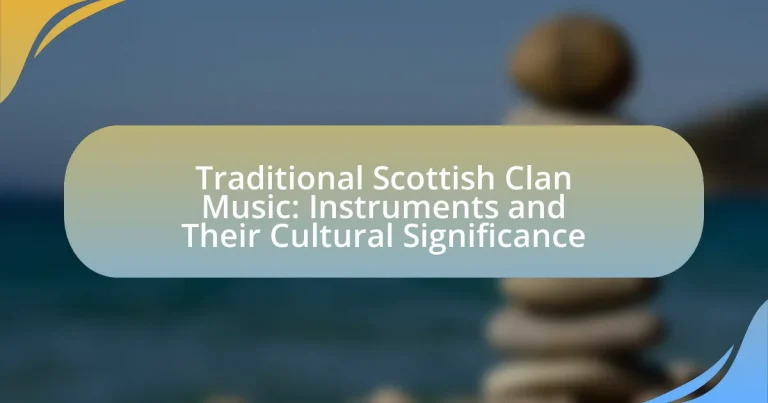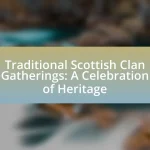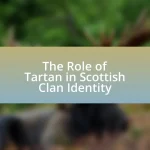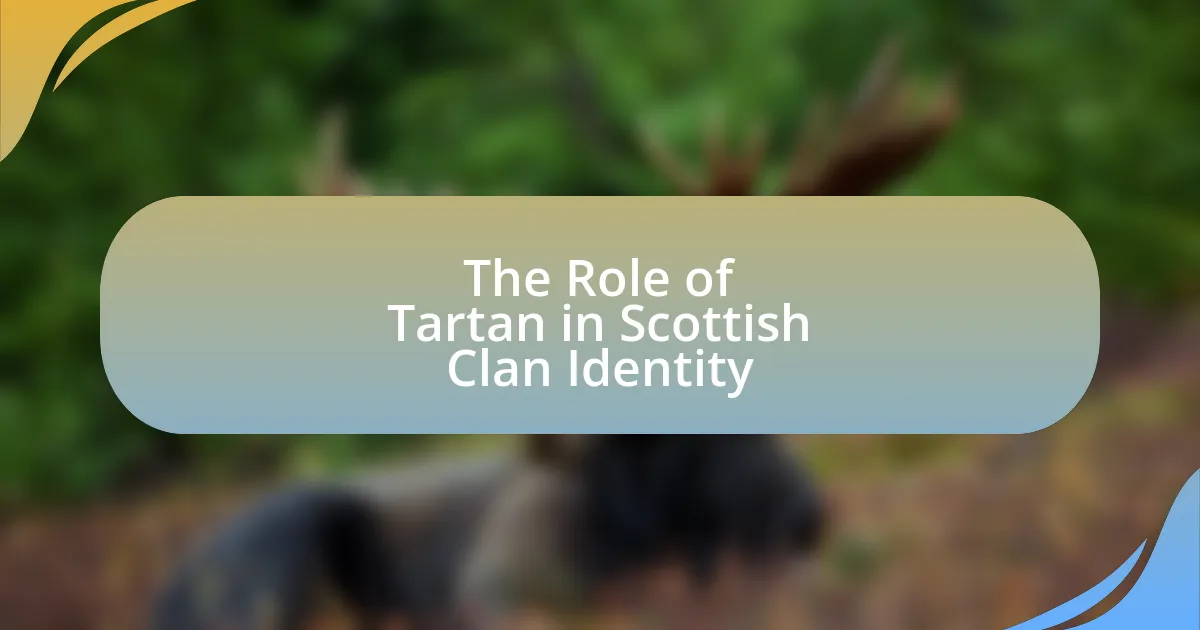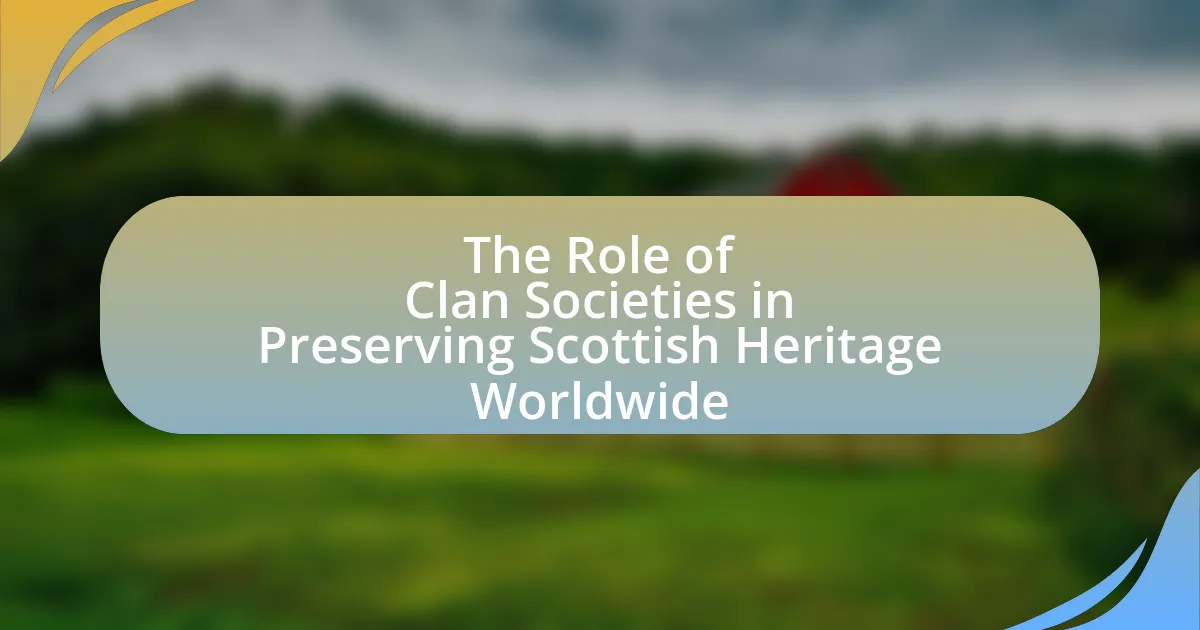Traditional Scottish Clan Music encompasses the musical traditions linked to Scottish clans, prominently featuring instruments such as bagpipes, fiddles, and drums. This genre serves as a vital expression of clan identity and cultural heritage, with historical roots that trace back to medieval times. The article explores the evolution of this music, its regional diversity, key characteristics, and the significant role it plays in Scottish traditions and celebrations. Additionally, it examines the impact of historical events on the music’s development, the importance of specific instruments, and contemporary influences that shape its ongoing relevance in modern society.
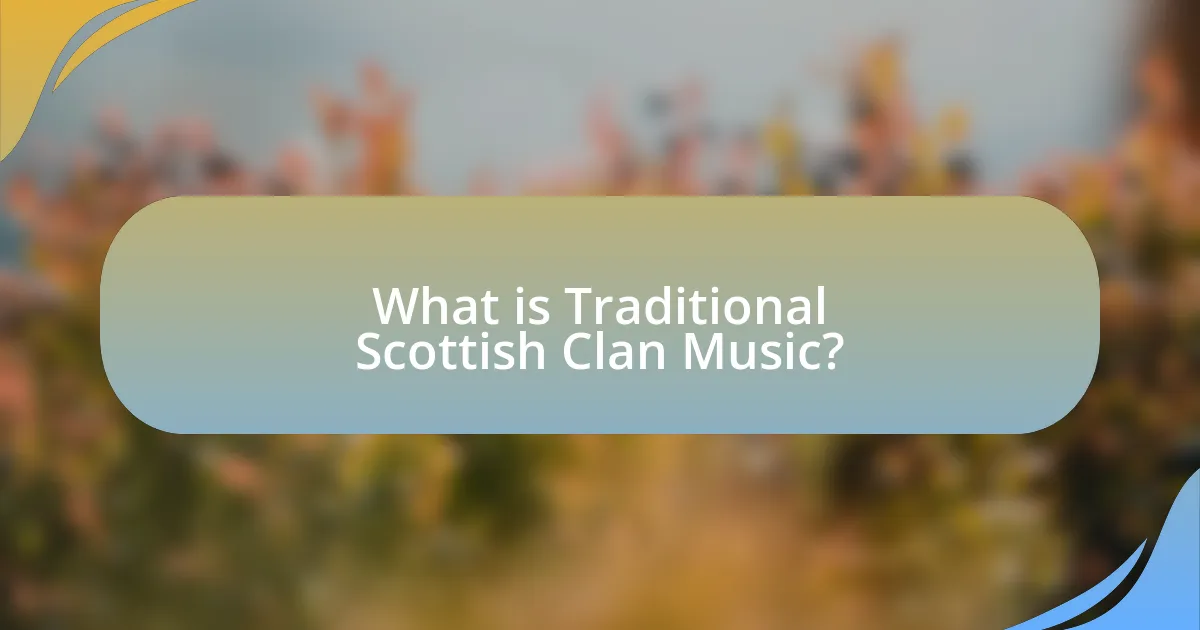
What is Traditional Scottish Clan Music?
Traditional Scottish Clan Music refers to the musical traditions associated with Scottish clans, characterized by the use of specific instruments such as bagpipes, fiddles, and drums. This genre of music often serves to express clan identity, heritage, and cultural values, with historical roots tracing back to the medieval period when clans used music for communication and celebration during gatherings and events. The significance of this music is underscored by its role in rituals, ceremonies, and social functions, reinforcing community bonds and preserving cultural narratives.
How has Traditional Scottish Clan Music evolved over time?
Traditional Scottish Clan Music has evolved significantly from its origins in the medieval period to contemporary interpretations. Initially, clan music primarily featured instruments like the bagpipe and fiddle, serving both ceremonial and social functions within clan gatherings. Over time, the music incorporated influences from various cultural exchanges, particularly during the Jacobite risings, which introduced new melodies and styles. The 19th century saw a revival of interest in folk traditions, leading to the preservation and adaptation of traditional tunes. Today, traditional Scottish Clan Music blends with modern genres, reflecting a dynamic cultural heritage while maintaining its historical roots.
What historical events influenced the development of this music?
The development of traditional Scottish clan music was significantly influenced by historical events such as the Jacobite uprisings of the 18th century. These uprisings, which aimed to restore the Stuart monarchy, fostered a strong sense of Scottish identity and nationalism, leading to the preservation and promotion of traditional music as a symbol of cultural heritage. Additionally, the Highland Clearances in the 18th and 19th centuries displaced many Scots, resulting in the migration of musicians and the spread of Scottish musical styles globally. This historical context solidified the role of instruments like the bagpipe and fiddle in clan gatherings and celebrations, reinforcing their cultural significance.
How do different regions of Scotland contribute to its diversity?
Different regions of Scotland contribute to its diversity through distinct musical traditions, instruments, and cultural practices. For example, the Highlands are known for their use of the bagpipe, which plays a central role in clan gatherings and ceremonies, while the Lowlands feature a variety of folk instruments like the fiddle and accordion, reflecting a different musical heritage. Additionally, the Western Isles incorporate Gaelic song traditions, which emphasize storytelling and community, showcasing the linguistic diversity within Scotland. Each region’s unique contributions to traditional Scottish clan music highlight the rich tapestry of cultural identities across the country.
What are the key characteristics of Traditional Scottish Clan Music?
Traditional Scottish Clan Music is characterized by its use of specific instruments, distinct melodies, and cultural themes. The primary instruments include the bagpipes, fiddles, and drums, which create a unique sound that is both powerful and emotive. Melodies often feature repetitive structures and are influenced by the oral tradition, allowing for variations in performance. Additionally, the music frequently reflects themes of clan identity, history, and storytelling, serving as a means of preserving cultural heritage. Historical records indicate that clan music played a vital role in gatherings and celebrations, reinforcing social bonds within communities.
What musical forms and styles are prevalent in this genre?
Traditional Scottish Clan Music predominantly features forms such as folk songs, ballads, and dance tunes. These musical styles are characterized by the use of instruments like the bagpipes, fiddles, and drums, which are integral to clan gatherings and celebrations. Folk songs often narrate historical events or clan stories, while ballads convey emotional tales, and dance tunes, such as jigs and reels, encourage communal dancing. The historical significance of these forms is evident in their role in preserving clan identity and heritage, as they have been passed down through generations, reflecting the cultural values and traditions of Scottish clans.
How do rhythm and melody play a role in its uniqueness?
Rhythm and melody are fundamental elements that contribute to the uniqueness of traditional Scottish clan music. The rhythm often features distinctive patterns that reflect the cultural heritage and social functions of the music, such as dance or ceremonial events. For example, the use of specific time signatures, like 6/8 or 4/4, creates a lively and engaging tempo that is characteristic of Scottish jigs and reels.
Melody in this genre typically employs pentatonic scales and modal structures, which are rooted in Scottish folk traditions. This melodic framework allows for expressive variations and improvisation, making each performance unique. The combination of these rhythmic and melodic elements not only distinguishes Scottish clan music from other musical traditions but also reinforces its cultural identity, as evidenced by the enduring popularity of instruments like the bagpipe and fiddle in clan gatherings and celebrations.
Why is Traditional Scottish Clan Music significant to Scottish culture?
Traditional Scottish Clan Music is significant to Scottish culture because it serves as a vital expression of identity, heritage, and community cohesion. This genre of music, often characterized by instruments such as the bagpipes and fiddles, reflects the historical narratives and traditions of various clans, fostering a sense of belonging among members. For instance, the use of specific tunes and songs can evoke memories of clan battles, celebrations, and rituals, thereby preserving the collective memory of Scottish history. Additionally, events like Highland games and clan gatherings prominently feature this music, reinforcing cultural ties and promoting the continuation of these traditions across generations.
How does this music reflect the identity of Scottish clans?
Traditional Scottish clan music reflects the identity of Scottish clans through its use of specific instruments, melodies, and cultural themes that embody clan heritage and history. Instruments like the bagpipe and fiddle are integral to clan gatherings and ceremonies, serving as a means of expressing pride and unity among clan members. The melodies often tell stories of clan battles, victories, and legends, reinforcing a sense of belonging and shared identity. For example, the “Flower of Scotland” is a song associated with Scottish nationalism and clan pride, highlighting the emotional connection clans have to their history. This music not only preserves the cultural narratives of the clans but also fosters community ties, making it a vital aspect of Scottish cultural identity.
What role does it play in Scottish traditions and celebrations?
Traditional Scottish clan music plays a central role in Scottish traditions and celebrations by serving as a means of cultural expression and community bonding. Instruments such as the bagpipes, fiddles, and drums are integral to events like weddings, funerals, and festivals, where they evoke a sense of heritage and identity. For instance, the bagpipe is often played at significant gatherings, symbolizing pride and unity among clans, and is recognized as a national symbol of Scotland. Historical records indicate that music has been a vital part of Scottish culture for centuries, with clan gatherings often featuring traditional tunes that reflect the clan’s history and values.
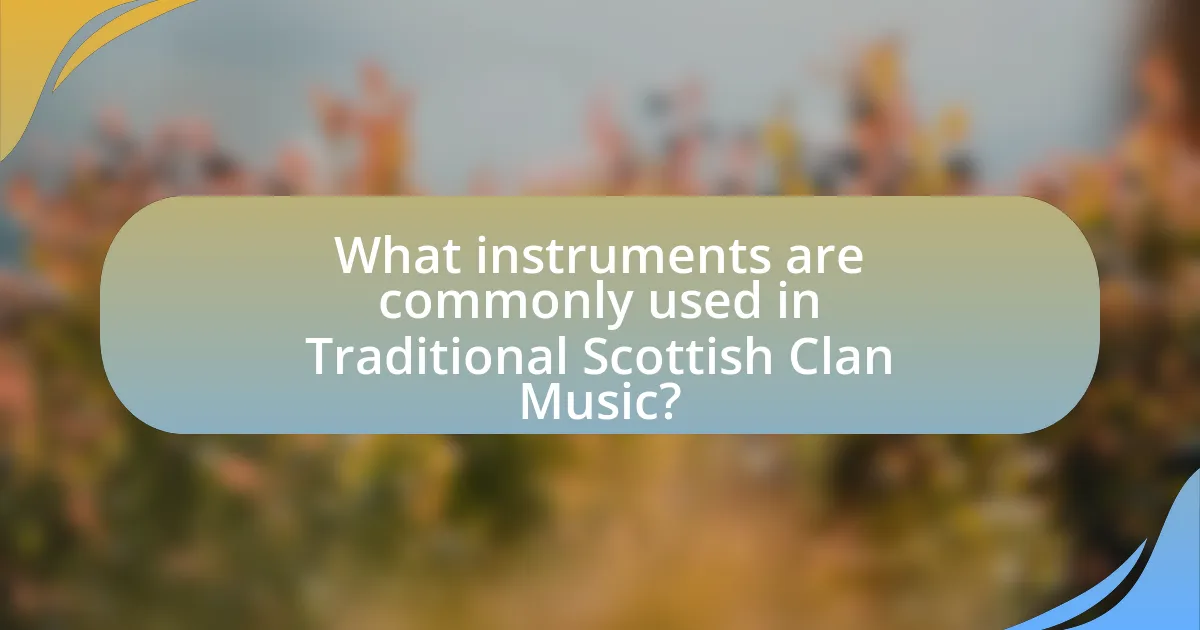
What instruments are commonly used in Traditional Scottish Clan Music?
Traditional Scottish Clan Music commonly features instruments such as the bagpipes, fiddle, and accordion. The bagpipes, particularly the Great Highland Bagpipe, are iconic in Scottish culture and are often played at clan gatherings and ceremonies. The fiddle, known for its expressive sound, plays a central role in traditional Scottish folk music, accompanying dances and celebrations. The accordion adds a rich harmonic texture to the music, enhancing the overall sound during performances. These instruments collectively contribute to the cultural significance of Scottish clan music, reflecting the heritage and traditions of Scottish clans.
How do different instruments contribute to the overall sound?
Different instruments contribute to the overall sound of traditional Scottish clan music by providing distinct tonal qualities and rhythmic patterns. The bagpipes, for instance, deliver a powerful and resonant sound that serves as a melodic foundation, while the fiddle adds intricate melodies and harmonies that enhance the emotional depth of the music. The bodhrán, a traditional drum, introduces a rhythmic backbone that drives the tempo and energizes the performance. Additionally, instruments like the accordion and flute contribute unique textures and layers, enriching the overall auditory experience. Each instrument plays a specific role, creating a cohesive sound that reflects the cultural heritage and communal spirit of Scottish clan music.
What are the most iconic instruments in this musical tradition?
The most iconic instruments in Traditional Scottish Clan Music are the bagpipes, fiddle, and drum. The bagpipes, particularly the Great Highland Bagpipe, are central to Scottish musical heritage, often played at clan gatherings and ceremonies. The fiddle, a key instrument in Scottish folk music, has roots in the 16th century and is essential for dance music. Drums, especially the bodhrán and snare drum, provide rhythmic support and are integral to both military and folk traditions. These instruments not only define the sound of Scottish clan music but also symbolize cultural identity and heritage.
How do the materials and construction of these instruments affect their sound?
The materials and construction of traditional Scottish instruments significantly influence their sound quality and tonal characteristics. For instance, the use of hardwoods like maple or cherry in the body of a bagpipe enhances resonance and projection, resulting in a richer sound. Additionally, the thickness of the wood affects the instrument’s timbre; thinner woods produce brighter tones, while thicker woods yield warmer sounds. The type of reeds used in instruments like the chanter also plays a crucial role; cane reeds provide a more vibrant sound compared to synthetic alternatives. Historical evidence shows that different regional styles of construction, such as the specific shaping of the bellows in a Scottish smallpipe, further contribute to the unique sound profiles associated with various Scottish musical traditions.
What is the role of the bagpipe in Traditional Scottish Clan Music?
The bagpipe serves as a central instrument in Traditional Scottish Clan Music, symbolizing cultural identity and heritage. Historically, bagpipes were used in various clan gatherings, ceremonies, and battles, providing a distinctive sound that united clan members and instilled a sense of pride. The instrument’s powerful and resonant tones were often employed to convey messages over long distances, making it essential for communication during conflicts and celebrations. Additionally, bagpipe music is integral to traditional Scottish events such as weddings and funerals, reinforcing its role in marking significant life moments within the clan.
What types of bagpipes are used in Scottish music?
The primary types of bagpipes used in Scottish music are the Great Highland Bagpipe, the Smallpipe, and the Border Bagpipe. The Great Highland Bagpipe is the most recognized and is traditionally associated with Scottish military and ceremonial music, featuring a loud and powerful sound. The Smallpipe, in contrast, is quieter and more suited for indoor playing, often used in folk music settings. The Border Bagpipe, originating from the Scottish Borders, has a distinctively different sound and is characterized by its use of a more mellow tone. These bagpipes play a crucial role in the cultural heritage of Scotland, reflecting the historical and social contexts of Scottish clan music.
How has the bagpipe’s significance changed over time?
The significance of the bagpipe has evolved from a primarily military and ceremonial instrument to a symbol of cultural identity and heritage. Historically, bagpipes were used in Scottish clans to rally troops and mark important events, such as battles and funerals, reflecting their role in warfare and community cohesion. Over time, particularly in the 19th and 20th centuries, the bagpipe became associated with national pride and cultural revival, especially during the Scottish Renaissance, where it was embraced as a symbol of Scottish identity. This shift is evidenced by the establishment of pipe bands and competitions, which further solidified the bagpipe’s status as a cherished cultural artifact rather than just a military tool.
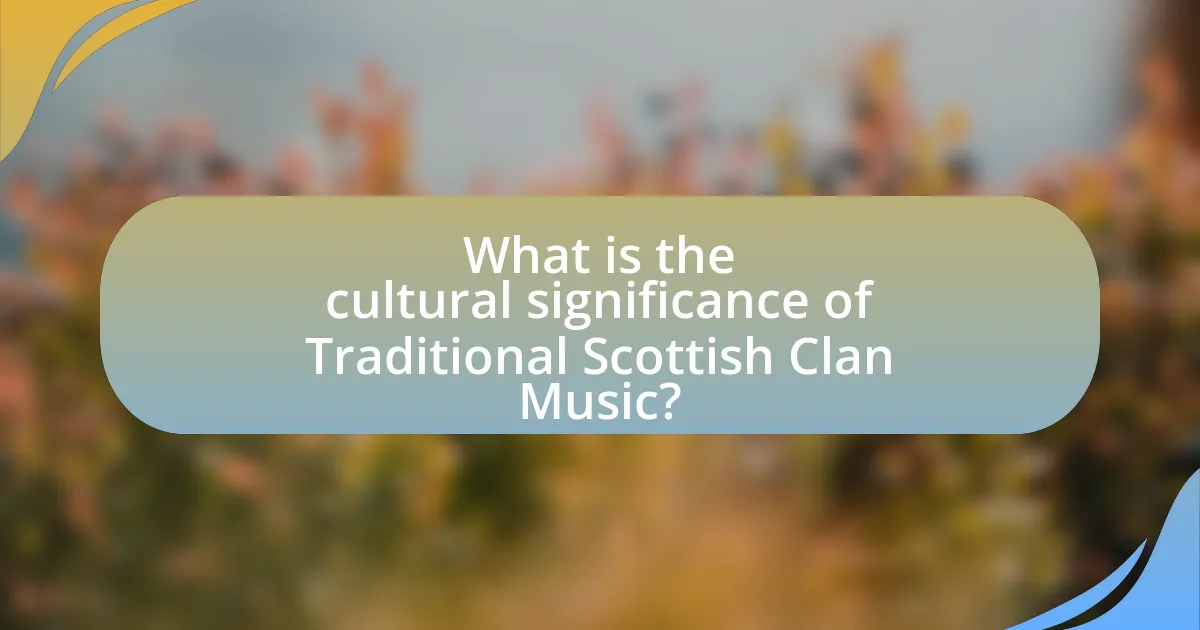
What is the cultural significance of Traditional Scottish Clan Music?
Traditional Scottish Clan Music holds significant cultural importance as it embodies the history, identity, and social cohesion of Scottish clans. This genre of music, often characterized by instruments such as the bagpipe and fiddle, serves as a medium for storytelling, preserving oral traditions and clan narratives that date back centuries. For instance, clan songs often recount historical events, battles, and the lineage of families, reinforcing a sense of belonging and pride among clan members. Additionally, traditional music plays a vital role in communal gatherings and celebrations, fostering unity and cultural continuity within Scottish society. The enduring popularity of clan music in contemporary Scotland further illustrates its role in maintaining cultural heritage and identity, as evidenced by events like the Edinburgh Festival and various Highland Games, where traditional music is prominently featured.
How does Traditional Scottish Clan Music foster community and connection?
Traditional Scottish Clan Music fosters community and connection by serving as a cultural touchstone that unites individuals through shared heritage and collective participation. The music often features instruments like the bagpipes and fiddles, which are integral to clan gatherings and celebrations, reinforcing social bonds. Historical events, such as clan battles and festivals, have utilized music to evoke a sense of belonging and identity among members, creating a communal atmosphere. Additionally, the practice of communal singing and dancing during clan events encourages interaction and strengthens relationships, making music a vital element in the social fabric of Scottish clans.
What events or gatherings celebrate this musical tradition?
Events that celebrate traditional Scottish clan music include the Royal Edinburgh Military Tattoo, the Highland Games, and various clan gatherings and festivals throughout Scotland. The Royal Edinburgh Military Tattoo showcases military bands and traditional Scottish music, attracting thousands of visitors annually. The Highland Games feature competitions alongside performances of bagpipe music, emphasizing the cultural significance of these instruments. Clan gatherings often include music as a central element, fostering community and heritage among clan members. These events highlight the importance of traditional Scottish music in preserving cultural identity and history.
How do clans use music to strengthen their bonds?
Clans use music to strengthen their bonds by facilitating shared experiences and reinforcing cultural identity. Traditional Scottish clan music, often performed during gatherings and celebrations, fosters a sense of unity among members through collective participation in singing and dancing. For example, the playing of bagpipes at clan events not only evokes a sense of pride but also serves as a reminder of shared heritage and history. This communal engagement in music creates emotional connections and enhances social cohesion, as evidenced by the longstanding tradition of clan ceilidhs, where music and dance are central to clan gatherings, promoting fellowship and solidarity among members.
What are the contemporary influences on Traditional Scottish Clan Music?
Contemporary influences on Traditional Scottish Clan Music include the integration of modern genres such as folk rock, pop, and electronic music. Artists like Capercaillie and The Proclaimers have blended traditional melodies with contemporary rhythms, attracting a wider audience and revitalizing interest in clan music. Additionally, the use of technology in music production has allowed for innovative arrangements and collaborations, further enriching the traditional sound. Festivals and cultural events also play a significant role in promoting these contemporary adaptations, ensuring that traditional Scottish clan music remains relevant in today’s musical landscape.
How are modern musicians incorporating traditional elements into their work?
Modern musicians are incorporating traditional elements into their work by blending traditional Scottish instruments, such as the bagpipe and fiddle, with contemporary genres like pop, rock, and electronic music. This fusion creates a unique sound that honors cultural heritage while appealing to modern audiences. For example, artists like Breabach and The Proclaimers have successfully integrated traditional melodies and rhythms into their compositions, showcasing the versatility of these instruments. Additionally, collaborations between traditional musicians and contemporary artists further enhance this integration, allowing for innovative interpretations of classic tunes.
What impact does globalization have on the preservation of this music?
Globalization has a dual impact on the preservation of traditional Scottish clan music, both promoting and threatening its existence. On one hand, globalization facilitates the dissemination of this music through digital platforms, allowing wider audiences to access and appreciate it, which can lead to increased interest and revitalization efforts. For instance, the rise of social media and streaming services has enabled traditional Scottish musicians to reach global audiences, thereby fostering cultural exchange and collaboration. On the other hand, globalization can dilute the authenticity of traditional music as it may lead to the commercialization of cultural expressions, where traditional elements are altered or simplified to appeal to broader markets. This phenomenon can result in the overshadowing of genuine cultural practices by more mainstream musical trends. Thus, while globalization can enhance visibility and appreciation, it also poses risks to the authenticity and traditional practices associated with Scottish clan music.
What are some practical ways to engage with Traditional Scottish Clan Music?
To engage with Traditional Scottish Clan Music, individuals can participate in local ceilidh dances, which often feature live traditional music, allowing for direct interaction with the genre. Additionally, attending festivals such as the Edinburgh International Festival or the Royal Edinburgh Military Tattoo provides opportunities to experience performances by skilled musicians. Learning to play traditional instruments like the bagpipes or fiddle through community classes or online tutorials can deepen personal involvement. Furthermore, joining a local clan society or music group fosters connections with others who share an interest in this cultural heritage, enhancing understanding and appreciation of the music’s significance.
How can individuals learn to play traditional instruments?
Individuals can learn to play traditional instruments through structured lessons, self-study, and community engagement. Structured lessons can be obtained from music schools or private instructors specializing in traditional music, where students receive tailored guidance and feedback. Self-study involves utilizing instructional books, online tutorials, and video resources that focus on specific traditional instruments, allowing learners to progress at their own pace. Community engagement includes participating in local music groups, workshops, or festivals, which provide opportunities for hands-on practice and cultural immersion. These methods are supported by the fact that many traditional music communities emphasize learning through oral tradition and peer interaction, enhancing both skill acquisition and cultural appreciation.
What resources are available for exploring this musical tradition further?
Books, academic journals, and online platforms are available for exploring Traditional Scottish Clan Music further. Notable books include “The Music of Scotland” by John Purser, which provides historical context and analysis of Scottish music traditions. Academic journals such as the “Scottish Music Review” publish research articles on various aspects of Scottish music, including clan music. Online platforms like the BBC’s “Scottish Music” section offer audio samples, articles, and resources for deeper understanding. These resources collectively enhance knowledge of the instruments and cultural significance associated with Traditional Scottish Clan Music.
